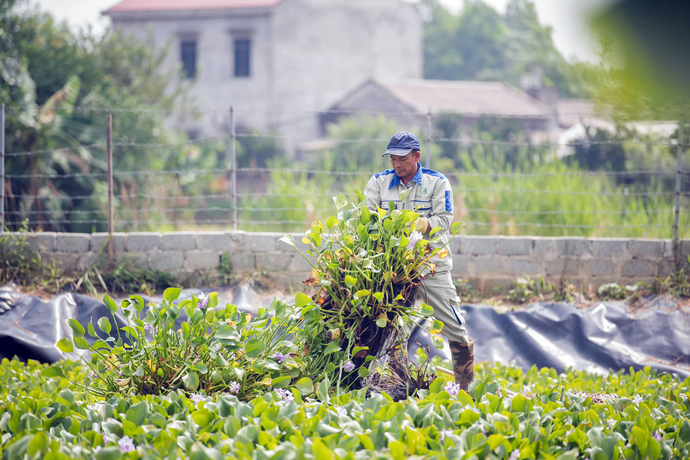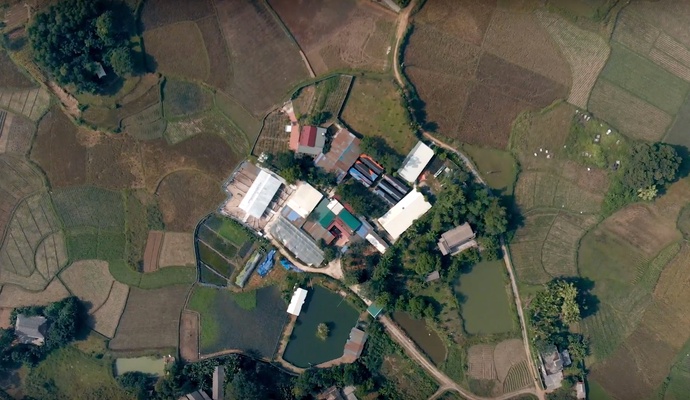As the previous craze of organic products has yet to recede from Vietnam’s agriculture sector, the country’s younger generation of farmers has already picked up on circular farming – the next big thing that promises sustainability by using no more acreage or resources than strictly necessary.
As soon as she wakes up in the morning, Nguyen Phuong Thao, 35, from Hanoi, gets herself in position to unload and package heaps of fresh produce sent from her family farmstead in Phu Tho Province before delivering them to customers.
Judging from the looks, not many would expect Thao to be a master’s degree holder and the owner of a booming farm-to-table business that adopts circular agriculture as their core practice.
After finishing a master's in environmental studies in the UK, Thao returned to Vietnam with concerns about rural environmental pollution and a desire to promote sustainable agriculture.
In 2017, Thao and her husband, Nguyen Luong Quyet, a construction engineer, went to Yen Lap District in northern Phu Tho Province to open ‘Nguyen Khoi Xanh,’ an organic farm and animal husbandry operation.
Two years later, the farm project won recognition from the Vietnamese government and the World Bank during the 'Women and the future of the Green Economy' forum.
As Thao sees it, circular farming can be understood as a closed-loop process that makes full use of every by-product.
The ‘waste’ from one operation can be reused as the input for another stage in the system — in other words, nothing goes to waste.
The model can be seen in practice at her farm, which keeps pigs and chickens as the main livestock.
Pig urine, which is high in organic matter and prone to cause pollution, will be kept in biogas tanks to generate clean fuel gas for the farm.
Meanwhile, the residue from the process is redirected into a second tank, which uses the filtration capability of water hyacinth plants to clear out toxins from the liquid. Output from this process can now be used as fertilizer.
Manure from the pigs can also be reused as food for Indian blue worms, but they have to undergo composting and mixing with water hyacinth pieces.
Farmed worms are an important link in the process at Nguyen Khoi Xanh, as they provide stable sources of protein for pigs and chickens, and can also be utilized as plant food when mixed with chicken manure.
Most of the processes are practically cost-free, but they ensure no resource from her farm is wasted, all while maintaining a wide variety of products for her business, according to Thao.
For the time being, the Phu Tho-based facility is supplying pork, chicken, vegetables, and fruits to five organic food stores and one international school in Hanoi, with truckloads of produce being shipped off every day.
|
|
| An aerial photo shows Nguyen Khoi Xanh, a farm practicing circular methods, in Phu Tho Province, Vietnam. |
Inflection point
With keywords of ‘circular farming,’ ‘circular economy,’ and ‘circular agriculture’ showing up in heavy rotation in recent years, one can infer that Vietnam’s agriculture sector is standing at an inflection point, where sustainable and regenerative practices are considered the future.
One of the early adopters of this movement is Tran Hoang Tam, 27, from Lap Vo District in the Mekong Delta province of Dong Thap, who converted his smallholding operation into circular practices in just a year.
Previously, his farm specialized in herbs and medicinal plants, namely blue peas, artichokes, lemongrass, jasmine, and mint, among others.
Striving to make use of the waste from his acreage, Tam erected a blue worm farm and fed them with remains from the trees, then hacked out a pond to raise worm-eating fish.
“My main source of income remains herb trees, but now I have additional profit from worm and fish farms, both of which are not labor-intensive,” Tam said.
The model, though working well at small operations, can also be scaled up and adopted by large facilities.
In April, leaders of Hau Giang Province in the Mekong Delta liaised with a large-scale farm, which spans over 2.3 hectares and attracted VND14.7 billion (US$645,600) in annual investment, to try out a project on circular farming.
It outlines separate sections for water hyacinths, blue worms, fruit plants, hydroponic farms, not to mention apparatuses for fermentation, mushroom farming, freeze dehydration, as well as raising black soldier fly larvae — a food that chickens can feed on.
The whole structure is expected to rake in VND21.3 billion ($934,000) in revenue over its first year of operation.
“Many are excited at the idea of circular farming,” said Dr. Vo Tong Xuan, a leading agriculturalist who has made great contributions to optimize Vietnam’s farming practices over the past 30 years.
As he pointed out, utilizing farmstead waste as production input will become the future of farming, considering threats of climate change in the next two decades will force producers to cut glasshouse emissions at the source through reusing and recycling.
“A solid definition of ‘circular’ has yet to be settled, but at the very core, it simply requires farmers to find ways of cutting waste and emissions,” Dr. Xuan stated.
|
|
| This supplied photo shows a farm practicing circular methods in Lam Dong Province, Vietnam. |
Stakes are high
To go the circular route, farmers must prepare for a long and strenuous process of transformation from what they have been accustomed to.
First off, location. It took Thao, the Hanoi woman, some four years to pin down Phu Tho’s Yen Lap District — a midland area surrounded by mountains, with a relatively cool atmosphere and access to clean water — as a suitable location for her venture.
“The farm must be located away from pollution sources, but not too distant from the consumer market in Hanoi,” Thao explained.
After breaking ground on their farm, Thao and her husband had to spend another three years building, learning, and seeking consultation from experts before her first product showed up on the market in 2019.
Product quality is one of their biggest concerns. While pigs fed with carbohydrate-heavy food turn out too fatty, cuts from swine that received more veggies in their diet were too dry.
After going through countless trial-and-error loops, the couple finally struck a proper balance to turn out perfect batches of pork, as well as poultry, veggies, and fruit, for the Vietnamese market.
Being a closed loop, Thao’s system will suffer as a whole if any link in the production chain breaks down.
For example, an epidemic, whether targeting livestock or plants, could interrupt production on the whole farm.
Keeping this in mind, Thao decided to build separate coops for farm animals to prevent cross-infection, plus enhancing the livestock’s natural immunity through organic intakes.
“Building a farm based on circular methods is a highly risky gamble, but the higher the risk, the higher the rewards,” Thao said.
According to her, it is almost impossible to make the farm fully self-sufficient, as she still needs to diversify the pigs’ food with corn and cassava from an outside supplier.
On a larger scale, experts also pointed out several challenges, including land shortage, funding requirements, and manpower, that may discourage any circular farming hopefuls.
Misinformed practices of circular agriculture can also exacerbate environmental pollution, warned Dr. Nguyen Thanh Hung, director of the Institute of Organic Agricultural Economics.
He pointed to the use of biochar in composting, which can result in sub-quality products with harmful microbes and heavy metal residues when not handled with correct timing.
On top of that, product quality can also be undermined by a number of protocol errors, including inferior animal feed, flawed coop design, or faulty irrigation systems.
Hung urged relevant authorities to devise a set of circular farming standards, which prescribes specific requirements for water sources, land, and organic residues in products for future reference.
“Nowadays, each step in agriculture production needs to be based on science, technology, and specifications,” he stated.
Like us on Facebook or follow us on Twitter to get the latest news about Vietnam!





















































